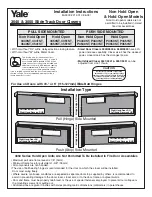
Electromagnetic compatibility (EMC)
- 34 -
04.19
909.1709.9-05
4
Ambient conditions
Temperature range of ambient air:
in operation: -10 °C ...+40 °C (+14 °F ...+104 °F)
Transport
and storage: -25 °C ... +55 °C (-13 °F ... +131 °F)
Relative humidity:
up to 50 % at 40 °C (104 °F)
up to 90 % at 20 °C (68 °F)
Operation, storage and transport may only
be carries out within the ranges indicated!
Use outside of this range is considered not
used with its intended purpose. The manu-
facturer is not liable for damages cause by
misuse.
Ambient air must be free of dust, acids,
corrosive gases or other damaging sub-
stances!
5
General regulation of use
The device is intended for welding steel, aluminium and
alloys in commercial and industrial application condi-
tions.
The device used for welding the following with direct
current
–
non-alloyed, low-alloy and high-alloy steels,
–
copper and its alloys
–
nickel and its alloys
–
Special metals such as titanium, zirconium and
tantalum,
for TIG welding with AC* of
–
aluminium and its alloys*,
–
magnesium and its alloys*
nd for MMA welding.
*) Only AC/DC
6
UVV inspection
Operators of commercially-operated welding systems
are obliged to have safety inspections of the equipment
carried out regularly in accordance with EN 60974-4.
Lorch recommends inspection intervals of 12 months.
A safety inspection must also be carried out after altera-
tions or repair of the system.
Improperly carried out accident prevention
regulation tests can lead to the destruc
-
tion of the system. For more information
on UVV inspections of welding systems,
please contact your authorised Lorch ser-
vice centre.
7
Unit protection
This machine is protected electronically against over-
loading. Do not use stronger fuses than those stated on
the type plate of the device.
Before welding, connect the workpiece to the machine
with the ground cable.
8
Electromagnetic compatibility
(EMC)
This product complies with the currently valid EMC
standards. Please observe the following:
Due to their high power consumption, welding ma-
chines can cause problems in the public power grid.
The mains connection is therefore subject to require-
ments with regard to the maximum permissible sys-
tem impedance. The maximum permissible system
impedance (Zmax) of the interface to the power grid
(mains connection) is indicated in the technical data.
If in doubt, please contact your power grid operator.
The unit is intended for welding under both commer-
cial and industrial application conditions (CISPR 11
class A). Use in other surroundings (for example in
residential areas) may disturb other electronic de-
vices.
Electromagnetic problems during commissioning can
arise in:
–
Mains cables, control cables, signal and telecom-
munication lines near the welding or cutting area
– TVs/radios
–
Computers and other control equipment
–
Protective equipment in commercial systems (e g
alarm systems)
–
Pacemakers and hearing aids
–
Equipment for measurement and calibration
–
Equipment with too little protection against distur-
bances
If other equipment in the vicinity shows signs of interfer-
ence, additional screening may be necessary.
The affected area can be bigger than your premises/
property. This depends on the construction of the
building and other activities being performed there.
Please use the machine in compliance with the manu-
facturer’s instructions. The machine operator is respon-
sible for installation and use of the machine. If electro-
magnetic malfunctions should occur, the plant operator
(possibly with the manufacturer’s technical assistance)
is responsible for the remedial measures.
















































